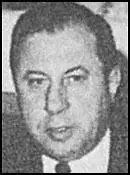Frank Ragano

Frank Ragano was born in 1923. His Sicilian born father ran a small store in Tampa. He joined the United States Army during the Second World War and won the Bronze Star while fighting in Germany.
After the war Ragano became a clerk for the Florida Supreme Court. In 1948 he began representing Mafia boss, Santos Trafficante. He also worked for New Orleans Mafia boss Carlos Marcello and in 1961 he defended Jimmy Hoffa against claims that he had plundered the Teamster Pension Fund.
In 1971, Ragano was arrested for tax evasion. One of his partners, Sam Rizzo, gave evidence against him in court. He was convicted and given 3 years probation. More importantly, he lost the licence needed to work as a lawyer. This was eventually regained in 1981 and in 1984 he represented Santos Trafficante in a racketeering trial.
In August 1990, Ragano was again charged with tax evasion. After a long struggle he was eventually sentenced to 10 months in prison. On 14th January, 1992, the New York Post claimed that Trafficante, Marcello and Hoffa had all been involved in the assassination of President John F. Kennedy. Ragano was quoted as saying that at the beginning of 1963 Hoffa had told him to take a message to Trafficante and Marcello concerning the plan to kill Kennedy. When the meeting took place at the Royal Orleans Hotel, Ragano told the men: "You won't believe what Hoffa wants me to tell you. Jimmy wants you to kill the president." He reported that both men gave the impression that they intended to carry out this order.
In his autobiography, Mob Lawyer (1994) (co-written with journalist Selwyn Raab) Ragano added that in July, 1963, he was once again sent to New Orleans by Hoffa to meet Santos Trafficante and Carlos Marcello concerning plans to kill President John F. Kennedy. When Kennedy was killed Hoffa apparently said to Ragano: "I told you could do it. I'll never forget what Carlos and Santos did for me." He added: "This means Bobby is out as Attorney General". Marcello later told Ragano: "When you see Jimmy (Hoffa), you tell him he owes me and he owes me big."
Ragano also told Dan E. Moldea of the Washington Post that the Garrison investigation of Clay Shaw, Guy Banister and David Ferrie was an attempt to divert public attention away from Carlos Marcello. According to Ragano "Garrison was shielding Marcello from being implicated in the Kennedy murder case," Ragano says.
Ragano also told the story of how Santos Trafficante remarked just four days before he died: "That Bobby (Kennedy) made life miserable for me and my friends... We shouldn't have killed John (Kennedy). We should have killed Bobby."
Primary Sources
(1) Frank Ragano, Mob Lawyer (1994)
Of the Mafia trio, only Roselli testified before the State committee. On July 19, 1975, the night before he was going to be questioned by committee members, Sam Giancana was preparing a supper... when a person he evidently trusted and had invited to share the meal ended his life by firing a .22 caliber handgun equipped with silencer into the back of his head. The killer followed up by discharging six more rounds into Giancana's neck and mouth.
Some organized-crime experts theorized that Giancana's murder was unrelated to the Senate inquiry, and that he was killed by rivals to stop him from regaining supremacy of Chicago's Mafia clan. From what I had picked up over the years about mob executions, the nature of Giancana's death contradicts that theory. In a traditional Mafia hit, a bullet in the throat signifies that the victim had been 'talking,' and a bullet in the mouth means he will never 'rat' again. Undoubtedly, Giancana was murdered to prevent him from talking about the CIA-Castro plot or any other Mafia secret.
Almost exactly on the first anniversary of Giancana's death, another layer of mystery was added to the coincidence of his slaying and the Senate's CIA investigation. After years of seemingly cooperating with congressional committees and talking rather freely with newspaper columnists about Mafia affairs, Johnny Roselli became extremely cautious, almost reclusive...
In late July 1976, Roselli made a dinner date. He was seen with his old friend Santo Trafficante at The Landings, a restaurant in Fort Lauderdale. Two days after dining with Santo, Roselli disappeared.
Twelve days later, on August 7, 1976, a fifty gallon drum containing the legless body of a silver-haired man... The corpse was Johnny Roselli.
The manner of Roselli's death also fit a Mafia pattern. He was beguiled to his death by someone he trusted. The dumping of his body in the bay was another message: The killers either wanted to give the impression that he had deliberately vanished or they wanted to punish his relatives for his misdeeds, perhaps his violation of omerta...
One fact, however, was indisputable: Santo Trafficante was the only survivor of the three mobsters recruited by the CIA to kill Fidel Castro.

